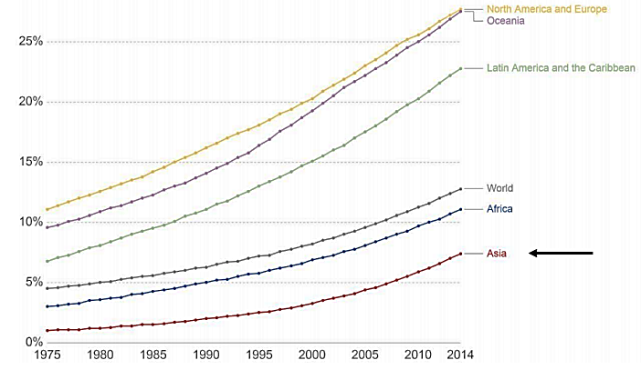Obesity is often seen as a U.S. problem, but it has now moved well beyond US borders. Earlier this month, experts from around the globe shared international perspectives during a National Academy of Medicine workshop addressing the global obesity pandemic. The U.S. may be a leader in its focus on obesity treatment, but we lag behind many other nations when it comes to preventing the disease. Below are some key takeaways from the meeting, including successes and challenges faced by other nations in their efforts to address the burden of obesity.
State of Obesity Globally
No nation has experienced a decrease in obesity prevalence over the last decade. In 2016, 390 million women and 281 million men were estimated to have obesity. Parallel obesity prevalence curves across nations (Figure 1) suggest this is not a localized problem: similar population-wide exposure to something, or everything, is driving the obesity epidemic globally.
UN Food and Agriculture Organization/WHO

Challenges Navigating the Obesity Epidemic
-
Obesity may be valued in some low and middle-income countries as a buffer against child undernutrition, or as an indicator of health in countries with a high prevalence of HIV infections. These observations underscore the need for regionally-tailored approaches that address the double burden of over- and undernutrition. Over 40% of countries face this double burden of malnutrition.
-
Food and beverage industries have globalized their businesses, and ultra-processed foods are now widely available and heavily marketed. In Latin America, industry opposition to efforts to restrict food marketing to children (Chile) or to pass an excise tax on sugary drinks (Mexico) has fostered mistrust and precluded collaborative solutions.
-
Globally, obesity disproportionately affects people of color, indigenous populations, and increasingly people of lower socioeconomic class. A variety of forces contribute to these disparities, including individual, institutional, and structural racism that leads to reduced access to healthful foods, food insecurity, and limited facilities for physical activity.
Global Obesity Prevention and Treatment Efforts
-
Speakers provided observational data and examples of innovative physical activity interventions from high and middle-income countries. Nonetheless, more experience is needed to understand how to make sustainable infrastructure changes that promote physical activity in rapidly industrializing areas.
-
Experiences abroad give credence to the importance of policies as plural. Small decreases from a variety of strategies are needed to combat the obesity pandemic.
-
Promising policy interventions to address obesity may include a combination of fiscal, regulatory, education, media, transport, urban development, and nutrition strategies.
The U.S. has contributed substantially to novel approaches to the field of obesity prevention and treatment, but there is a great deal that we can learn from our colleagues in other countries. Particularly when existing strategies prove ineffective, international perspectives may provide innovative approaches to addressing obesity in the U.S.
Recordings from the workshop, slide decks, and speaker bios are available for viewing and download from the National Academies website.


